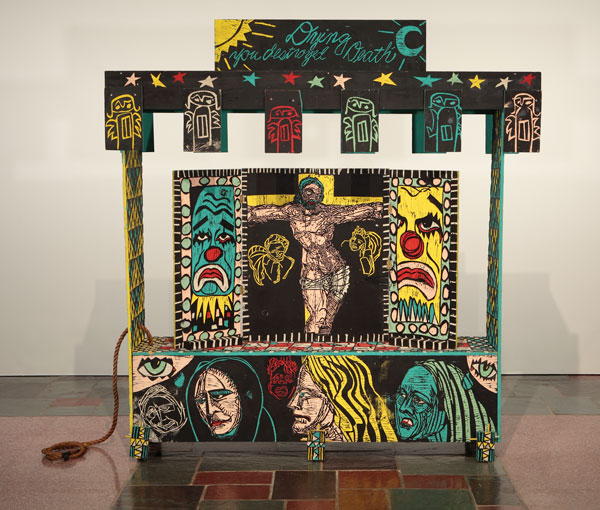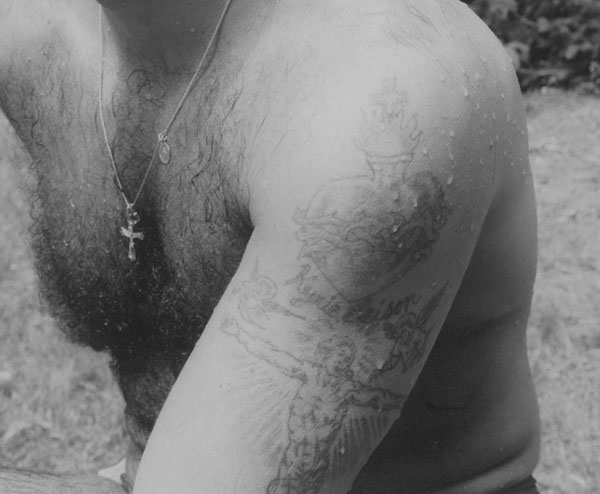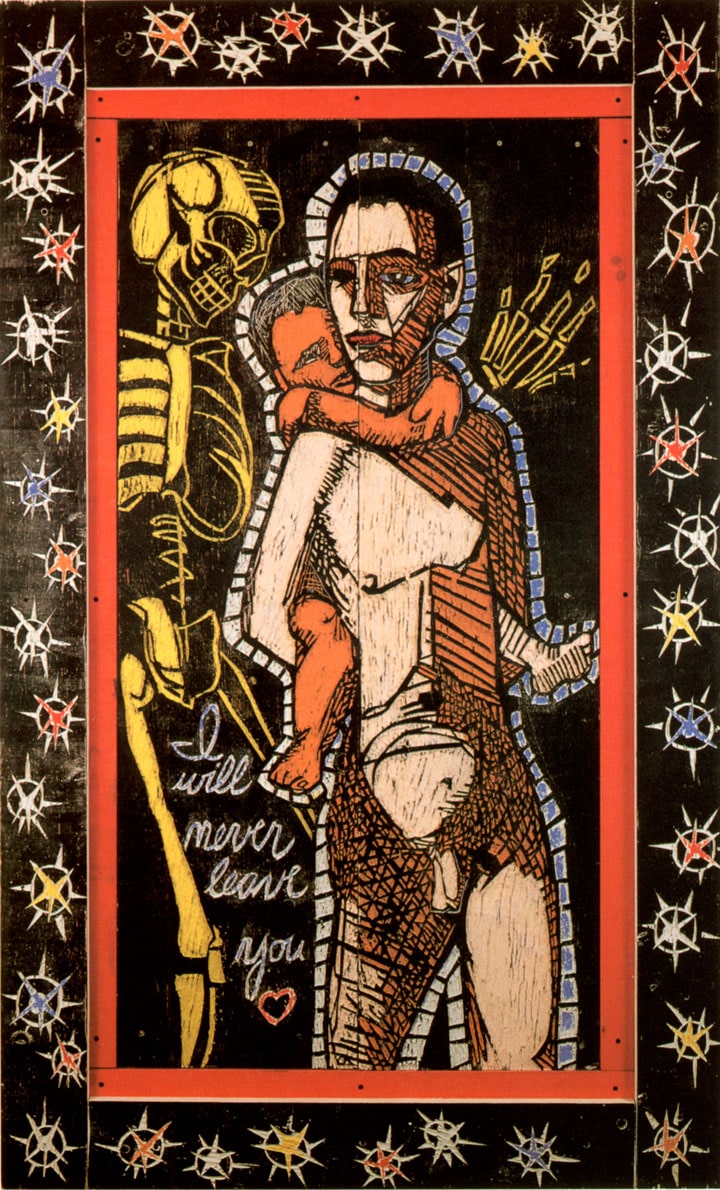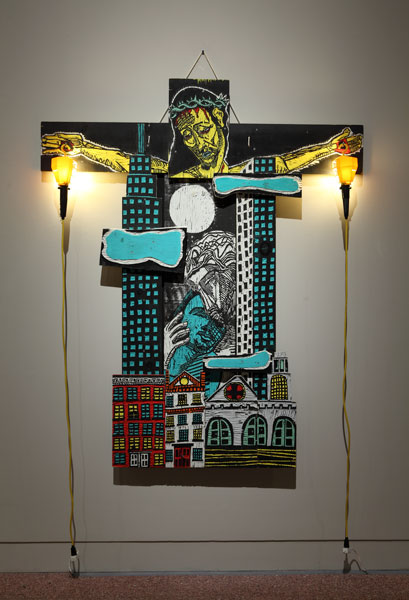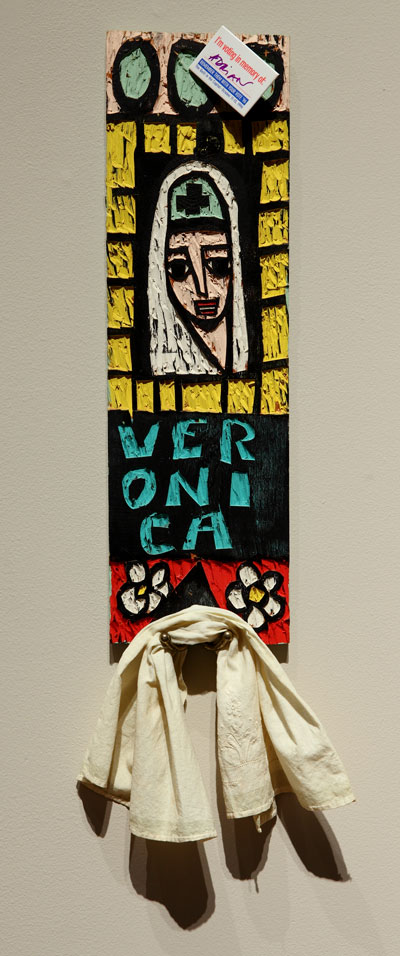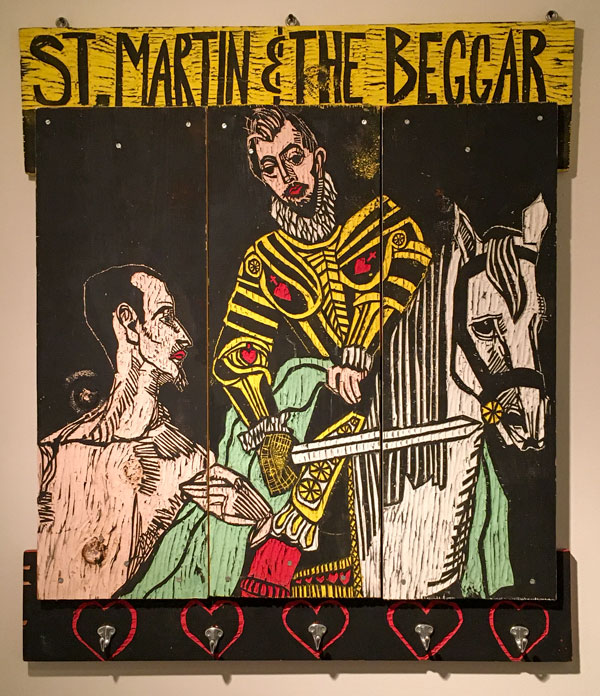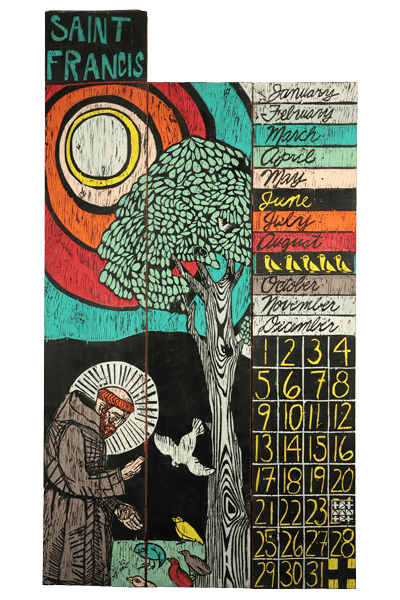Episode 2: Adrian Kellard
Release date: Nov. 1, 2011
Adrian Kellard was a gifted artist whose life was cut short by AIDS in 1991. MOCRA is fortunate to have the largest collection of Kellard’s work in any single art institution. In 2011, thirty years after the identification of HIV and twenty years after Kellard’s death, MOCRA presented a solo exhibition featuring a number of Kellard’s most important works.
It was also a fitting time for MOCRA Director Terrence Dempsey, S.J., to speak with photographer Regina DeLuise, a close friend of Kellard, and Susan Schreiber, Kellard’s New York gallery dealer. Together they share stories of Kellard that serve to illuminate his artistic aims and influences, his distinctive visual style and treatment of his woodcut medium, and the ways in which Kellard’s upbringing, sexual orientation, and faith found expression in his work.
Regina DeLuise noted,
For the last twenty years, the work of Adrian Kellard has been in my care. Since he and I were the same age, (born two days apart, same year) . . . The parallels of my life and Adrian's have always been sharply drawn and alive to me. What would Adrian's life and work looked like had his life not been cut short by AIDS in 1991? It is extraordinary to see anew, not only the depth of his talent, dedication and commitment to his art and his faith, but also how prolific he was. The work at MOCRA represents the largest collection of Adrian's work anywhere (and a number of his most important pieces). The Grey Art Gallery, Neuberger Museum, Ali Forney Institute, and The American Visionary Museum also hold magnificent works in their collections. My hope is that Adrian’s work continues to be seen and appreciated, inspiring people to realize their best and most loving selves. I have kept Adrian’s work safe and protected over the years, but have not accomplished much else for him. My gratitude to Fr. Terrence Dempsey is profound. He is to be credited with recognizing the importance of this work when Adrian was alive, and never tiring in his efforts to present it to the world. To see the exhibition at MOCRA and the tremendous care and attention both Terry and David Brinker have shown has been extraordinarily moving to those of us who knew and loved Adrian.
Scroll down for a Listening Guide to this episode.
MOCRA Voices on Stitcher MOCRA Voices on iTunes MOCRA Voices on Spotify
Related Exhibitions
Adrian Kellard: The Learned Art of Compassion
Vast Bhutan: Images from the Phenomenal World - Photographs by Regina DeLuise
Related Episode
Credits
Producer: David Brinker
Recording Engineer and Editor: Fojammi (Daniel Stefacek)
Host: John Launius
Listening Guide: David Brinker
Background
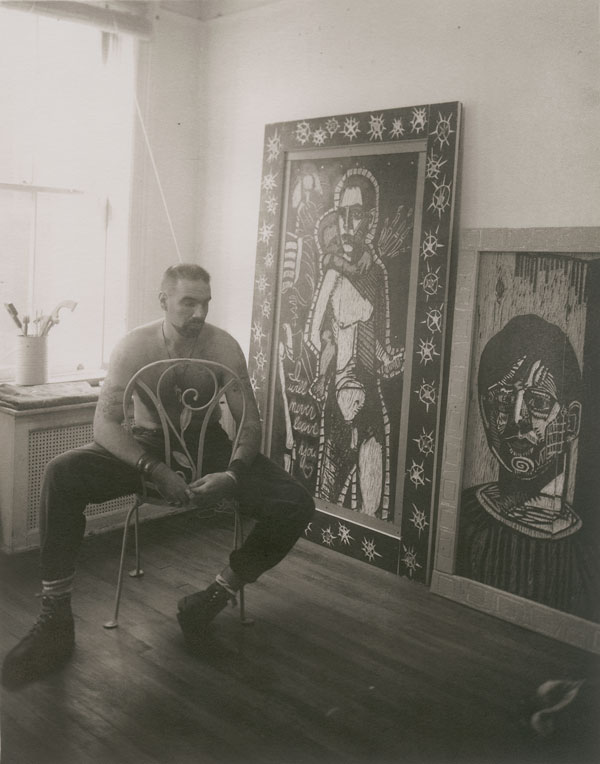 American artist Adrian Kellard (1959–1991) had a brief but productive career that was cut short by his death from
AIDS-related causes at the age of 32. Kellard pursued art studies at SUNY Purchase,
then moved to New York City and studied under artist Thomas Lanigan-Schmidt. Kellard
achieved national and international recognition. His work has been featured in exhibitions
at the Isabella Stewart Gardner Museum in Boston, New York University’s Grey Art Gallery,
the Center on Contemporary Art in Seattle, the Musée d’Art Contemporain de Montréal,
and the American Visionary Art Museum in Baltimore. (Photo: Regina DeLuise, “Adrian Kellard in His Studio,” 1989. Palladium print. MOCRA collection.)
American artist Adrian Kellard (1959–1991) had a brief but productive career that was cut short by his death from
AIDS-related causes at the age of 32. Kellard pursued art studies at SUNY Purchase,
then moved to New York City and studied under artist Thomas Lanigan-Schmidt. Kellard
achieved national and international recognition. His work has been featured in exhibitions
at the Isabella Stewart Gardner Museum in Boston, New York University’s Grey Art Gallery,
the Center on Contemporary Art in Seattle, the Musée d’Art Contemporain de Montréal,
and the American Visionary Art Museum in Baltimore. (Photo: Regina DeLuise, “Adrian Kellard in His Studio,” 1989. Palladium print. MOCRA collection.)
Learn more about Adrian Kellard
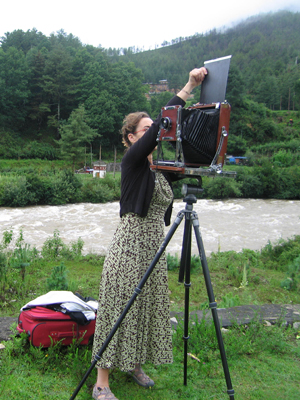 Regina DeLuise is a photographer and educator based in Baltimore, Maryland. She received a BFA at
the State University of New York at Purchase and an MA at the Rosary College Graduate
School of Fine Arts in Florence, Italy. She has taught and given workshops on photography
at several major institutions, including the Smithsonian Institution, Cooper Union,
and Pratt Institute. She has been teaching photography at Maryland Institute College
of Art since 1998. DeLuise has shown in numerous solo and group exhibitions across
the United States and Europe as well as in Japan and Bhutan. Her work is in the collections
of the Museum of Modern Art in New York, the Metropolitan Museum of Art, the Corcoran
Gallery of Art in Washington, DC, the San Francisco Museum of Modern Art, and the
Art Institute of Chicago, to name just a few. DeLuise’s work was featured in the 2015
MOCRA exhibition “Vast Bhutan: Images from the Phenomenal World.”
Regina DeLuise is a photographer and educator based in Baltimore, Maryland. She received a BFA at
the State University of New York at Purchase and an MA at the Rosary College Graduate
School of Fine Arts in Florence, Italy. She has taught and given workshops on photography
at several major institutions, including the Smithsonian Institution, Cooper Union,
and Pratt Institute. She has been teaching photography at Maryland Institute College
of Art since 1998. DeLuise has shown in numerous solo and group exhibitions across
the United States and Europe as well as in Japan and Bhutan. Her work is in the collections
of the Museum of Modern Art in New York, the Metropolitan Museum of Art, the Corcoran
Gallery of Art in Washington, DC, the San Francisco Museum of Modern Art, and the
Art Institute of Chicago, to name just a few. DeLuise’s work was featured in the 2015
MOCRA exhibition “Vast Bhutan: Images from the Phenomenal World.”
Visit Regina DeLuise’s website
Susan Schreiber has worked with contemporary artists in New York City for over 30 years. She established her gallery in Soho in 1986 and was pleased to present a solo show of Adrian Kellard's work as the inaugural exhibition. The gallery lasted for 5 years during which time Adrian's work was featured in annual solo shows as well as group exhibitions. She is proud to have been Adrian's dealer and friend until his death in 1991. Since then Susan has worked as a private dealer and art consultant. From 1995 until 2010 she was the director of PS122 Gallery, a small non-profit gallery which provided exhibition and support services for emerging artists. During that time she worked closely with artists, curators and critics to help launch a successful website for the gallery and developed new and innovative programs to allow artists to create unusual installations and collaborations. She has served on several juries for arts councils and alternative art spaces. Susan is currently exploring additional aspects of arts administration in her new role as Volunteer Coordinator at The Jewish Museum in New York.
Listening Guide
| 04:40 | Dr. Jody Cutler received her B.A. from New York University in 1981 and worked as a gallerist and art dealer in New York for more than a decade before returning to academia. Her recent research has been focused on ethnicity and visual representation in the West through time; African American Art; methodologies of art analysis; and the dynamics of exhibition culture. | |||||
| 05:15 |
Schreiber mentions two Manhattan neighborhoods that were the epicenters of thriving and at times competing arts scenes. The East Village had its heyday during the 1970s and 1980s. Among the visual artists prominent on the scene were Kiki Smith, Keith Haring, Goldin, Jean-Michel Basquiat, David Wojnarowicz, James Romberger, Rick Prol, and Jeff Koons. Read an elegy to the East Village scene by artist Gary Indiana. The SoHo neighborhood began to attract galleries out of the East Village in the late 1980s. Following a perhaps inevitable bout of gentrification, SoHo in turn ceded its claim as the heart of the New York arts scene to Chelsea a decade later. |
|||||
| 06:35 | Adrian Kellard’s work was featured prominently in the MOCRA solo exhibition “The Learned Art of Compassion” (2011). His work has also been shown in rotation as part of MOCRA's permanent collection. | |||||
| 07:35 |
June 5, 1981, marked the first published descriptions of the disease that would come to be known as acquired immunodeficiency syndrome, or AIDS, a complex of opportunistic infections that take advantage of an immune system weakened by infection with the human immunodeficiency virus, or HIV. Learn more about HIV and AIDS. AVERT provides this timeline of the AIDS epidemic. It may be difficult to appreciate just how devastating the impact of HIV/AIDS was upon those infected in the early years. Lack of scientific knowledge about the disease and its causes led to unfounded rumors and consequent discrimination against, and ostracizing of, both HIV+ patients and people in high risk groups, particularly gay men. (When Kellard died on November 14, 1991, he was considered a long-time survivor, having lived with the disease for five years.) The epidemic devastated whole communities with predominantly gay residents, yet also led to grassroots activism to address the needs of the ill, to educate those at risk, to fund scientific research, and to influence government policy and public opinion. The initial U.S. government response was distressingly tepid, but has since become more robust. The arts community, which has been disproportionately affected by HIV/AIDS, responded to the crisis in the most natural way it could, through the creation and presentation of art. Twenty-eight artists were featured in the 1994 MOCRA exhibition “Consecrations: The Spiritual in Art in the Time of AIDS”. Each year on World AIDS Day (December 1), galleries and museums observe Day With(out) Art by displaying (or sometimes remove) works of art to mark the impact of HIV/AIDS on the arts community. MOCRA has participated in many Day With(out) Art observances; For Day With(out) Art in 2009, MOCRA featured Kellard’s work “The Promise.” |
|||||
| 08:30 |
“Shrine,” also known as “The Wagon Piece,” was the first work by Kellard to get national exposure; images of it appeared in a number of publications following its appearance in the 1985 group exhibition “Precious: An American Cottage Industry of the Eighties” at New York University’s Grey Art Gallery. The work rests on wheels, evoking mobile shrines in popular Catholic religious outdoor processions. It also is reminiscent of the wagons that functioned as stages for medieval mystery plays. The quotes on the panel atop the work are drawn from the Eucharistic Prayers of the Roman Catholic Mass; the full expression is: “Dying you destroyed our death, rising you restored our life. Lord Jesus, come in glory.” On the “Dying” side of the work, the crucified Christ (a quote from a drawing by Michelangelo—see the discussion of Kellard's tattoos below) is flanked by large clown faces. The juxtaposition of religious and circus imagery is is jarring, and their meaning is ambiguous. The panel at the base of the Crucifixion contains a number of faces, including Jesus’ mother Mary, expressing grief. On the reverse, “Rising” side, we find a large face of Christ with a tender and sad expression. The panel below makes reference to the Sacred Heart of Jesus, a popular Catholic devotion (see below at 15:15). On either side of the Sacred Heart are many dwelling places: in the country, in small towns, and in the city. For Kellard, the Sacred Heart represented Christ’s unconditional love for all humanity, no matter where we reside. Kellard’s blending of high and folk art in “Healing . . . The Learned Art of Compassion,” results in a shrine dedicated to people with AIDS, but accessible to all of us. It invites us to draw on our higher qualities—compassion, understanding, and love. This work is a summation of many of the themes and images found throughout Kellard’s work. The face of Jesus, with gaunt features much like those of a person with advanced AIDS, looks out from a prominent place atop the canopy. To the right of the canopy is the crucified Jesus and to the left is a protective and vigilant Mary with wings watching over Adrian, whose self-portrait is contained in the square box beneath the face of Mary. The altar-like box beneath the canopy bears a quote from the Gospel of John calling for a sense of understanding and compassion. On the face panel of the box a supine figure evokes the entombed Christ, but is in fact a self-portrait of Kellard as a man with AIDS, with images of grief, hatred, and death to his right. To either side of the base of the canopy posts figures of Mary and St. John keep vigil. On the wall above, an image of Mary with the legend “Pray for Us” is framed by the names of the days of the week, which in turn are separated by lighthouses, beacons of safety and hope in stormy times. A pine panel depicting a small boat is moved from lighthouse to lighthouse to mark each day. This shrine seems free of anger and bitterness. Kellard’s use of the word “healing” certainly encompasses the hope of physical healing, but perhaps more importantly it anticipates a spiritual healing among us all—a healing from prejudice and hatred to understanding and compassion. |
|||||
| 11:30 |
Fr. Dempsey’s Ph.D. dissertation was titled “The Pursuit of the Spirit: The Re-Emergence of Spiritual and Religious Concerns in American Art of the 1980s.” Read this MOCRA blog post or listen to Episode 14: MOCRA Memories–Berkeley, for more about the role of the dissertation in the genesis of MOCRA. Thomas Sokolowski organized “Precious: An American Cottage Industry of the Eighties” in 1985 for New York University’s Grey Art Gallery. Find the exhibition catalogue through WorldCat. Read brief discussions of the exhibition in New York Magazine and the Christian Science Monitor. Sokolowski played a key role in the founding of Visual AIDS, the organization that launched Day With(out) Art in 1989. (Listen to Episode 3: Thomas Sokolowski to learn more.) Visual AIDS works for HIV prevention and AIDS awareness through visual art projects, provides assistance to artists living with HIV/AIDS, and preserves and promotes the legacy of HIV+ artists. A similar legacy initiative, the Estate Project for Artists with AIDS, is now housed in the archives of the New York Public Library. |
|||||
| 12:30 | Thomas Lanigan-Schmidt (b.1948) is known for creating glittering mixed-media constructions that speak directly to issues of sex, class and religion, particularly gay and working-class consciousness as well as theological, philosophical and aesthetic ideas/ideals. An art pioneer in the use of reflective materials, he has influenced subsequent generations of artists—including Adrian Kellard—who have engaged a similar “glitter” aesthetic, exploring themes of glamour, sexual transgression, camp and kitsch, and the relationship between “high” and “low” culture. Lanigan-Schmidt was featured in the retrospective “Tender Love Among the Junk” at MoMA PS1 in 2012. | |||||
| 15:15 |
This photo shows some of the tattoos mentioned by Fr. Dempsey and DeLuise. From the top, visible are: The Sacred Heart, a devotion popular primarily among Roman Catholics, with roots in the medieval period but popularized by St. Margaret Mary Alacoque in the seventeenth century. The Sacred Heart is commonly depicted as a flaming heart pierced by the wound of the centurion's lance, surrounded by the Crown of Thorns and surmounted by the Cross. The references to Jesus' suffering and death are paired with a fire representing the transformative power of divine love. Kyrie eleison is a Greek phrase meaning, “Lord, have mercy.” It appears frequently in Christian liturgical texts, often as a response to a litany of petitions or invocations. Kellard’s Crucifixion tattoo is based on a drawing by Italian Renaissance master Michelangelo Buonarroti (1475–1564), a gift to his friend and confidante, poet Vittoria Colonna, and now in the collection of the British Museum. Watch a brief BBC film about Michelangelo’s drawings. |
|||||
| 16:45 |
Kellard’s work titled “The Promise” references the legend of St. Christopher, whose name derives from the Greek for “Christ bearer.” According to legend he unknowingly carried the child Christ across a dangerous river. The image of St. Christopher was especially popular in the Medieval, Renaissance, and Baroque periods. He became the patron saint particularly of travelers, but also of athletes. In “The Promise,” Kellard portrays himself in the role of St. Christopher. The enigmatic text, “I will never leave you,” seems to assert love, hope, compassion, and loyalty. The image expresses endurance and perseverance in the midst of suffering. Yet it remains ambiguous as to which figure is speaking the words, or perhaps they are addressing each other. “The Promise” was included in the 1992–1993 international traveling exhibition “From Media to Metaphor: Art about AIDS” (“The Promise” is mentioned in The New York Times review of the exhibition), and in the 1994 exhibition “Art’s Lament: Creativity in the Face of Death,” organized by the Isabella Stewart Gardner Museum in Boston. |
|||||
| 17:35 | Read the Biblical passage Isaiah 43:2 in various translations. | |||||
| 21:45 | See the discussion above at 7:35. | |||||
| 25:05 |
“Lovers” is at once inclusively anonymous with the high skyscrapers of the New York skyline, and intimately autobiographical with the inclusion of the Kellard’s New York apartment building and his neighborhood church. The identities of the figures sheltered under the crucified Christ are not immediately clear: two lovers, or perhaps Christ cradling the beloved disciple. In either case, the figure on the left is a self-portrait of the artist. The identities are less important than the compassion, care and trust the figures express. |
|||||
| 26:50 |
“Compassion,” generally referring to an awareness of and ability to share the suffering of others, along with a desire to alleviate that suffering, is a term that has resonance among all the world's great faith traditions. The Charter for Compassion, launched in 2009 by author Karen Armstrong, is a movement that seeks to restore and promote compassion as a central virtue of religions and, indeed, all facets of life. Episode 21: Art, Empathy, and Healing, explores how the related concept of empathy is understood, explored, and employed in museums and other settings. |
|||||
| 31:05 | Read an overview of woodcut printing, or visit MoMA’s German Expressionism website for an introduction to the techniques of carving, inking, and printing from wood blocks. |
|||||
| 32:30 |
Kellard incorporated religious imagery into everyday, often functional objects, conveying playfulness without irreverence. Regina DeLuise mentions that Kellard often gave his functional artworks to friends as gifts, including this small towel rack featuring St. Veronica. Veronica does not appear in the New Testament, but she is remembered in the Christian tradition as a model of compassion for her selfless gesture of wiping the face of Jesus with a cloth as he carried his cross to Calvary. In return for her act of courage and care, an impression of Jesus’ face remained on the cloth (the name Veronica is popularly said to be derived from Latin and Greek words for “true image”). For Kellard, there was no separation between art and everyday life, as with this art work that doubles as a functioning coat rack: Frequently Kellard drew upon his knowledge of Catholic saints and of famous artistic depictions of those saints. The “St. Martin of Tours coat rack” quotes a painting by El Greco of St. Martin of Tours and the Beggar. (See the source painting in the National Gallery of Art collection.) The fourth-century saint was a soldier in Constantine's army. While stationed in Amiens, France, Martin reportedly encountered a beggar suffering from the cold one winter day. In an act of compassion, the saint sliced through his own cloak and gave one half to the beggar. |
|||||
| 34:30 |
According to the Museum of Modern Art, German Expressionism . . . encompasses a host of individuals and groups with varying stylistic approaches who moved in multiple directions toward a new style emphasizing intense personal expression. Renouncing the stiff bourgeois social values that prevailed at the turn of the 20th century, and rejecting the stale traditions of the state-sponsored art academies, they turned to boldly simplified or distorted forms and exaggerated, sometimes clashing colors. Directness, frankness, and a desire to startle the viewer characterize Expressionism in its various branches and permutations . . . The Expressionists had a long history of woodcut printing to draw on, stretching back to Albrecht Dürer and earlier. By severely simplifying the images, the Expressionists took advantage of the medium's affinity for bold, flat patterns and the telltale grain and rough hewn look of the blocks. Kellard’s SUNY Purchase instructor Antonio Frasconi (1919–2013) was born in Buenos Aires but raised in Montevideo, Uruguay. He emigrated to the United States in 1945 and distinguished himself as an artist, illustrator of books, and teacher. One of his major projects, illustrations for the book “Los desaparecidos”, concerns the grave human rights abuses committed in Uruguay under military dictatorship in the 1970s and 1980s. See examples of his work in the MoMA collection. |
|||||
| 35:25 |
This depiction of the popular St. Francis of Assisi also serves as a beautifully carved privacy screen. Kellard bases his image of St. Francis on a fresco by Giotto (1266/7–1337). (View the source work here.) The screen’s rightmost panel features a functional calendar that is meant to be changed on a daily and monthly basis. In the catalogue from the 1986 exhibition, “Contemporary Screens: Function, Decoration, Sculpture, Metaphor,” Kellard speaks directly to the issue of the everyday aspect of his art and faith in a way that is simple and illuminating: “I can remember watching a religious program on television in which the interviewer asked the priest how one has more faith. The priest said—and I think it to be true—that having faith is an activity, that by living with faith one will no doubt become more faithful, and that by living with love one will become more loving. The calendar signifies, that by engaging the intercession of St. Francis daily, monthly and yearly, we may be inspired by his life and values to help ourselves in our (life).” |
|||||
